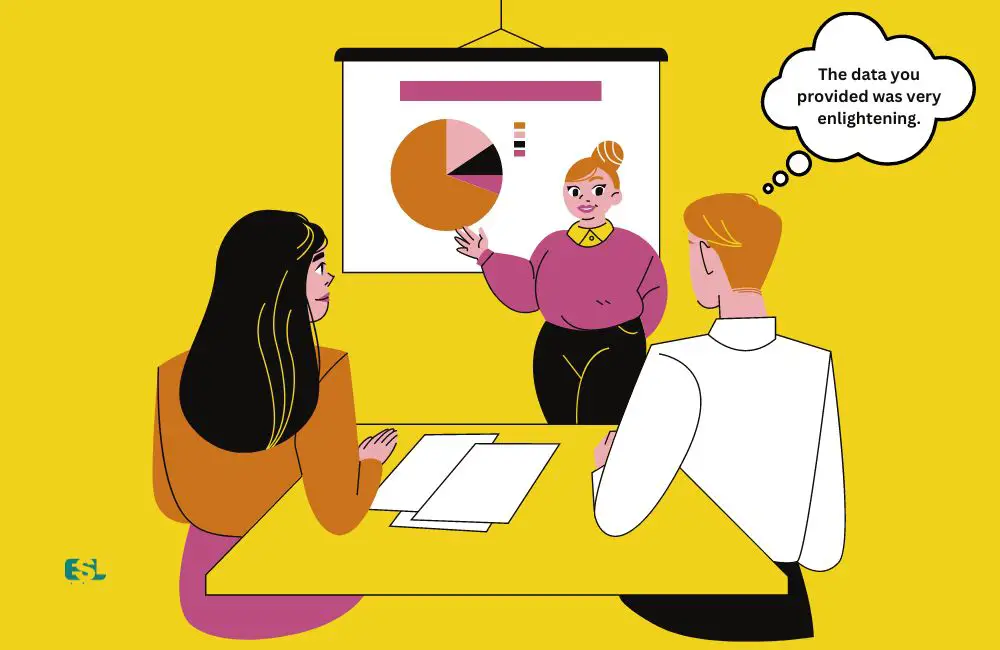In any professional or educational context, presentations are crucial to exchanging ideas and knowledge. So is appreciating people’s presentation regardless of an educational or professional context. Learning to appreciate a presentation enhances the speaker’s confidence and builds a supportive environment, fostering better communication and understanding.
To appreciate a presentation in English, use phrases like “Excellent job, your presentation was insightful” or “Your analysis was enlightening.” Be genuine, specific in compliments, and follow-up post-presentation. Employ encouraging body language and offer constructive feedback as well.
Are you looking for a book or a guide to help you learn and improve your English? You may try English Made Easy Volume One: A New ESL Approach: Learning English Through Pictures (Amazon Link).
As you delve deeper into this article, you’ll find a wealth of phrases and practical tips to express appreciation more effectively. Each section is carefully designed to enhance your ability to give meaningful feedback. Continue reading to understand how each tip can be implemented, accompanied by relevant examples to provide a clear understanding.
Table of Contents
- Why is Appreciation Important?
- Useful English Phrases for Appreciating a Presentation
- Tips for Appreciating a Presentation
- Sample Conversation: Appreciating a Presentation in English
- In Conclusion
- 10 Frequently Asked Questions Related to Appreciating a Presentation in English
Why is Appreciation Important?
Appreciation is a powerful tool that can significantly transform the landscape of communication and knowledge sharing, especially in the context of presentations. By providing genuine and thoughtful feedback, we not only acknowledge the effort and time invested by the speaker but also pave the way for an environment that cherishes learning and growth.
There are two key facets to understanding the role and impact of appreciation – it encourages speakers and fosters a positive environment.
1. To Encourage Speakers
Presentations often involve substantial research, planning, and preparation. Recognizing this effort is crucial in making the speaker feel acknowledged and appreciated. This recognition goes beyond simple words of praise; it’s a form of motivation that helps speakers enhance their performance and strive for better future endeavors.
Boosting Confidence
When you appreciate a presentation, you are effectively instilling confidence in the speaker. This validation gives them a sense of accomplishment, which motivates them to improve their skills further.
Example: “I really enjoyed your presentation; you tied all the facts together. You should be proud of your effort.”
Enhancing Delivery
Appreciation also has a direct impact on the delivery of the presentation. Positive feedback encourages speakers to continue refining their presentation skills, which ultimately leads to more effective delivery of information in the future.
2. To foster a Positive Environment
Appreciation is a key ingredient in fostering a positive environment. It’s a catalyst for creating an atmosphere that values shared learning and mutual respect. It goes beyond benefiting just the speaker, as the ripple effects can be seen throughout the group or organization.
Promoting Mutual Respect
When presenters recognize their efforts, it uplifts their spirits and cultivates a culture of respect. The appreciation sets a precedent for other members to respect and value each other’s contributions.
Enhancing Communication
By appreciating a presentation, you indirectly facilitate a more open and receptive form of communication. Presenters are more likely to be receptive to questions and discussions, which leads to a more engaging and interactive session.
Example: “Thank you for that enlightening presentation. It has given me a new perspective on [topic]. Let’s explore this further in the discussion.”
Building a Supportive Culture
Appreciation fuels a sense of camaraderie and support among peers. It encourages everyone to support each other’s ideas and presentations, leading to a more collaborative and inclusive environment.
You can create a more engaging, supportive, and productive environment by implementing a culture of appreciation. It goes beyond just a simple ‘well done’ and can significantly enhance the overall communication process, making it more effective and rewarding for everyone involved.
Useful English Phrases for Appreciating a Presentation
Communicating appreciation effectively requires a well-curated arsenal of phrases. The right words can inspire, motivate, and contribute to a positive atmosphere of learning and cooperation. In the context of presentations, appreciation can be broadly categorized into three segments: General appreciation, appreciation for content, and complimenting presentation skills.
1. General Appreciation
An overall appreciation of a presentation acknowledges the speaker’s effort and hard work. This recognition is especially encouraging for speakers, as it serves to validate their efforts. Here are some phrases that can be used to express general appreciation for a presentation.
- Excellent job on the presentation, it was very informative.
- Your presentation was outstanding, I was captivated throughout.
- Your talk was both engaging and illuminating.
- I must say, that was an impressive presentation.
- Your presentation was so captivating, I lost track of time.
- Well done, your presentation was very inspiring.
- Fantastic job, your presentation was thorough and comprehensive.
- I really enjoyed your presentation, it was high in quality and rich in content.
- Good job, the presentation was both informative and entertaining.
- Your presentation was remarkable, it was clear you put a lot of thought into it.
- I must commend your presentation skills, they were superb.
- Your presentation was exceptional, I found it very insightful.
- I appreciated your clarity and depth in the presentation.
- Great presentation, it was evident you knew your topic well.
- Your presentation was riveting, it kept me on the edge of my seat.
- Your presentation was noteworthy, it made me think in new ways.
- Brilliant work on your presentation, it was truly enlightening.
- Your presentation was well-delivered and very interesting.
2. Appreciating Content
Appreciating the content of a presentation is vital, as it shows the presenter that their research and analysis have been recognized. Here are some phrases to appreciate the content of a presentation.
- The facts you provided were well-researched and thought-provoking.
- Your deep dive into the impacts of climate change was thoroughly engaging.
- The data you provided on the recent economic trends was very enlightening.
- Your analysis was on point and made the topic of artificial intelligence more understandable.
- Your breakdown of the complexities of quantum physics was comprehensive and well-explained.
- You presented the information on the French Revolution very logical and clear.
- I was captivated by your insights on the evolution of digital marketing.
- Your in-depth research on the development of human rights was commendable.
- I appreciate the thorough analysis you provided on the global effects of COVID-19.
- Your case studies on successful startup businesses helped clarify your points.
- Your discussion on the influence of social media in politics was well-artificially and enlightening.
- I learned a great deal from your in-depth exploration of the philosophy of existentialism.
- Your approach to tackling the subject of mental health was refreshing and insightful.
- I really appreciated your fresh perspective on the challenges of space exploration.
- Your understanding of the principles of sustainable agriculture was evident in your presentation.
- Your commentary on the implications of the fourth industrial revolution was very insightful.
- Your detailed exploration of the cultural nuances in linguistics was very enriching.
- Your research on the historical implications of World War II was compelling and well-presented.
3. Complimenting Presentation Skills
Complimenting presentation skills can motivate speakers to continue improving and honing their skills. Here are some phrases to compliment the presentation skills.
- Your presentation style was dynamic and captivating.
- The flow of your presentation was seamless and well-structured.
- Your command over the subject was impressive.
- The clarity of your speech made the content easily understandable.
- The way you involved the audience was commendable.
- I was impressed by your confident demeanor and eloquent speech.
- Your use of visuals was impactful and helped to explain the subject better.
- The way you handled questions was admirable.
- Your body language and gestures added to the effectiveness of the presentation.
- Your clear and concise speaking style held everyone’s attention.
- I was impressed by your ability to articulate complex concepts in a simple way.
- Your use of anecdotes and examples made your points more relatable.
- Your confident presentation style was infectious and engaging.
- Your skillful use of data visualization made complex data easy to understand.
- Your eye contact and positive demeanor enhanced your connection with the audience.
- Your pacing and rhythm during the presentation were spot on.
- The way you maintained audience engagement was impressive.
- Your enthusiasm for the topic was infectious and added to the presentation.
Armed with these phrases, you will be equipped to appreciate presentations effectively and constructively, thereby creating an environment that values effort, fosters mutual respect, and encourages continuous learning and improvement.
Tips for Appreciating a Presentation
Understanding how to express appreciation after a presentation goes beyond simply knowing what to say. It involves authenticity, clarity, and even body language. To truly resonate with the presenter, appreciation must be sincere, targeted, and expressed verbally and non-verbally.
Furthermore, continuing the dialogue after the presentation can cement your appreciation and encourage further interaction. Below, we explore these principles in more detail.
#1 Be Genuine in Your Appreciation
The foundation of effective appreciation lies in sincerity. An authentic compliment resonates far more with the speaker than generic praise. If you’re struggling to find a specific aspect to commend, you can always appreciate the presenter’s effort or the depth of research involved.
- I appreciate the effort you put into this presentation.
- It’s clear you’ve done an immense amount of research.
- You’ve obviously put a lot of time into this, and it shows.
- I can see the hard work you put into this presentation.
- Your dedication to the topic was evident.
- The energy you put into the presentation was commendable.
- Your commitment to making this presentation informative is appreciable.
#2 Be Specific in Your Compliments
Being specific in your compliments indicates that you were attentive and truly engaged in the presentation. It helps the presenter understand which aspects were particularly successful and impactful.
- Your explanation of the impact of deforestation on the global climate was really insightful.
- The way you presented the concept of Schrödinger’s cat made it easy to understand.
- Your discussion about the nuances of postmodern literature was truly enlightening.
- I found your insights on the psychological effects of social media very valuable.
- The part about the civil rights movement in the 1960s really stuck with me.
- Your interpretation of the theory of relativity was quite unique.
- Your presentation’s segment on the biochemical reactions involved in photosynthesis was particularly engaging.
#3 Employ Encouraging Body Language
Non-verbal cues are just as important as verbal ones. A smile, nod, or maintaining eye contact can significantly enhance the impact of your appreciation. Here is how different body languages work.
- A simple nod during the presentation shows your engagement.
- Maintaining eye contact during your feedback conveys sincerity.
- Smiling while expressing your appreciation makes it more uplifting.
- An open posture shows your receptiveness to the presenter’s ideas.
- Gesturing naturally as you speak demonstrates your enthusiasm.
#4 Post-Presentation Follow-Up
After the presentation, a follow-up conversation, email, or note reinforces your appreciation and provides an opportunity for a more detailed discussion about the presentation. Some follow-up steps can be the following.
- Sending an email post-presentation to commend the speaker’s efforts.
- A one-on-one conversation about specific parts you found insightful.
- A handwritten note expressing your appreciation.
- Asking further questions about the topic shows your interest.
- Acknowledging the presenter in a group meeting or a public forum.
#5 Constructive Feedback
In addition to appreciation, offering constructive feedback is also beneficial. It helps the presenter identify areas of improvement and shows your commitment to their growth.
- Acknowledging a challenging area of the presentation and offering your thoughts.
- Providing gentle suggestions for improvement.
- Discussing any unanswered questions you had during the presentation.
- Sharing your thoughts on the pacing and structure of the presentation.
- Suggesting different methods or tools the presenter could use in the future.
By implementing these tips, your appreciation will be well-received and serve to encourage and motivate the presenter for their future presentations. It builds a supportive atmosphere that values shared learning and open communication.
Sample Conversation: Appreciating a Presentation in English
Situation: After a business conference, Emma and Raj are discussing a presentation they just witnessed by a keynote speaker.
Emma: Raj, wasn’t that presentation by Dr. Williams absolutely captivating?
Raj: Absolutely, Emma! I was thoroughly impressed by how he articulated his points. The way he structured the entire presentation made it so easy to follow.
Emma: Yes, and his use of visual aids and graphs really helped in understanding the complex data. It wasn’t just informative but also visually appealing.
Raj: I agree. His eloquence and command over the subject were evident. And the way he engaged the audience with questions and interactive polls was a masterstroke.
Emma: Absolutely! And I must say, his closing remarks were inspiring. It made me reflect on our current strategies and consider new approaches.
Raj: Me too. We should definitely commend him for such a stellar presentation. It was a learning experience.
In Conclusion
Appreciating a presentation in English involves a combination of effective phrases, genuine admiration, and careful consideration of your body language and post-presentation interactions. By mastering the art of appreciation, you create a supportive environment that fosters learning, encourages presenters, and enhances communication.
Whether you’re applauding the presenter’s efforts, complimenting specific points, or providing constructive feedback, remember to be honest, specific, and encouraging. With the tips and phrases provided in this article, you’ll be well-equipped to appreciate presentations in a way that motivates and uplifts the speaker.
10 Frequently Asked Questions Related to Appreciating a Presentation in English
1. How can I start my appreciation for a presentation?
You can begin with phrases like, “I was thoroughly impressed by…” or “The presentation was truly enlightening because…”
2. What elements of a presentation should I focus on when appreciating?
Highlight the content, delivery, visual aids, structure, and the speaker’s engagement with the audience.
3. How can I comment on the presenter’s speaking skills?
Use terms like articulate, eloquent, clear, and engaging to describe their speaking skills.
4. How should I talk about the content of the presentation?
You can mention if it was informative, well-researched, relevant, and insightful.
5. Are there specific terms to describe the visual aids used in the presentation?
Yes, terms like clear, effective, relevant, and engaging can describe the visual aids.
6. How can I appreciate the structure of the presentation?
You can mention if it was well-organized, cohesive, and easy to follow.
7. What if there were interactive elements in the presentation?
Highlight how they enhanced engagement, facilitated understanding, and added value to the presentation.
8. How can I conclude my appreciation?
Summarize the key takeaways, express gratitude for the insights, and convey your eagerness for future presentations by the speaker.
9. Is it appropriate to provide constructive feedback along with appreciation?
Yes, but ensure your feedback is constructive, polite, and aimed at improvement.
10. Can I use the appreciation to reflect on personal or business implications?
Absolutely! Relating the presentation’s content to your own experiences or future strategies can be a testament to its impact.






